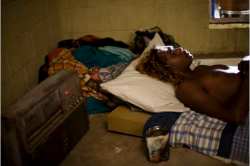
You won’t be alone if you come out of Samson and Delilah in a dream-like state, as the mesmerising power of this new Australian film is overwhelming. Once you come back to your senses you may find yourself becoming suddenly aware that such a film is long overdue. Cinematic representations of contemporary Indigenous Australians are extremely rare, yet alone representations of the communities living in abject poverty in central and northern Australia. However, Samson and Delilah is not a didactic, social-realist issue film with an axe to grind, but a skilfully crafted teen romance that is as beautiful as it is confronting. Set in an isolated community in the Australian desert, Samson and Delilah is about the growing understated love between two Indigenous Australian teenagers. While Delilah looks after her ill grandmother, Samson spends his days sniffing petrol, begging and generally being a nuisance. They have little in common but after both becoming victims of violence they team up, leave their community and head to Alice Springs to fend for themselves.
Samson and Delilah at times evokes the early works of Martin Scorsese, especially Scorsese’s use of subjectivity which in turn had been influenced by 60s and 70s European art house cinema. The open shot of Samson waking up to the sound of his brother’s band strongly evokes the opening of Mean Streets where Charlie wakes up to the sounds of New York City. However, instead of an American urban environment, Samson and Delilah must negotiate the streets and fringes of an Australian city, which are filled with the indifferent, the desperate, the exploitive and the predatory.

Non-professional locals were cast instead of trained actors to ensure that all the performers ‘owned’ their stories. The results are incredibly successful. The entire cast inhabit each role tremendously but Rowan McNamara as Samson and Marissa Gibson as Delilah are absolute revelations. Gibson is a natural in front of the camera and has the extraordinary ability to convey Delilah’s inner strength in just one look. McNamara possesses an unpredictable, rebellious energy and at times he embodies the spirit of a young Heath Ledger.
Samson and Delilah is the first feature by writer/director Warwick Thornton and it is an astonishing début. Thornton’s background as a cinematographer is evident as the film’s immaculately composed and predominantly static cinematography allows the nuances of the relationship between Samson and Delilah to be fully expressed with virtually no dialogue. For most of the film an impressive sound design evocatively substitutes for dialogue, helping to establish its steady, hypnotic pace. Brief bursts of violence and trauma therefore contain maximum impact without ever feeling exploitive. Samson and Delilah is extraordinarily powerful and very much adheres to the “don’t say what you can show” rule of filmmaking. It’s an excellent example of visual storytelling, a compelling slow burning story, and it truly feels like the beginning of something new and special in Australian cinema.
Read Cinema Autopsy’s interview with writer/director Warwick Thornton and producer Kath Shelper.
![]()

Sounds a bit like the movie Beneath Clouds. Similar theme but in an urban setting. I still remember how haunting the lead girl was.
To my shame I still haven’t seen Beneath Clouds so I can’t make any comparisons. Samson and Delilah really is amazing though so I urge everybody to try and see it this weekend. Unfortunately the opening weekend audience numbers can have a massive impact on whether a film gets a decent cinema run or gets pulled early.
I’ll come back and read this review once I’ve seen the film next week. All I’ve taken note of is your 4.5 stars. I’ve heard really great things about the film from some and others who were largely unimpressed. I also heard it compared to Beneath Clouds, which is one of my favourite Australian films.
Saw the film last night and I think both your score and your comments are spot on. I think that the film “is not a didactic, social-realist issue film with an axe to grind” is part of what really elevates it to something more sublime. In my review, I describe the story as ethnographic, an inside look into a culture that we know little about.
Are you going to the media screening of Thornton’s shorts tomorrow? If so, I’ll see you there. I’ve heard good things about them.
I’m glad to hear that you enjoyed Samson and Delilah as much as I did Paul. I missed that media screening this morning as I was (as usual) preparing for “The Casting Couch”, the film show I do Saturday afternoons on JOY 94.9. See the On Air page for more details.
We actually interviewed writer/director Warwick Thornton and producer Kath Shelper on the show a couple of weeks ago and you can read a transcript here.
The shorts are very good and I highly recommend them. You can see both his evolving style as well as the consistent themes. Thornton’s a story teller, and while there’s obviously fire in his belly, he’s not out to preach or teach per se. The potentially didactic themes are subtly there in the background, similar to the way Kelly Reichardt handles them in say Old Joy or Wendy and Lucy. Thanks for the links.
Benicio, there are some comparisons with Beneath Clouds.
The obvious difference with Ivan Sen’s film is that his is a road movie and one of his protagonists is on the run from the law. Thornton’s film is relatively static, so to speak, basically with the story taking place in two locations. The film is concerned with their existence and the way they relate.
Beneath Clouds does depict a developing relationship, and the way Lena and Vaughn relate is not so dissimilar. Their cultural experience as aborigines is quite different to those of Samson and Delilah, whose culture is much more remote.